Dell Inspiron 8200 Pentium 4-M 2.0GHz
by Matthew Witheiler on October 23, 2002 4:29 AM EST- Posted in
- Laptops
Construction - Under the Hood
The Inspiron 8200 that Dell provided us with came loaded with some of the most powerful components available in laptops today. Our test Inspiron 8200 came with a Mobile Pentium 4-M 2.0GHz processor, 512MB DDR memory, a 40GB 5400RPM hard drive, an internal DVD/CD-RW drive, and the latest mobile graphics processors provided via a an NVIDIA GeForce4 440 Go mobile graphics module and an ATI Mobility Radeon 9000 graphics module (replaceable mobile graphics boards that are proprietary to Dell).
The 2.0GHz Mobile Pentium 4-M at the heart of our Inspiron 8200 is the second fastest mobile Intel CPU out there currently, second to the recently announced Mobile Pentium 4-M running at 2.2GHz. At 2.0GHz, the Mobile Pentium 4-M provides plenty of processing power. As you will recall from previous mobile articles, the Mobile Pentium 4-M processors are the same as desktop Northwood Pentium 4 processors with the addition of SpeedStep technology. On identical systems on AC power, a Mobile Pentium 4-M should perform exactly like a desktop Pentium 4 clock for clock. Making the Mobile Pentium 4-M processor more at home in a mobile environment is the addition of SpeedStep technology. In the case of the 2.0GHz Mobile Pentium 4-M processor, SpeedStep gives the processor the ability to dynamically clock itself between the full clock speed of 2.0GHz and the power saving speed of 1.2GHz.
The CPU in the Inspiron 8200 may not be advertised as end-user upgradable but it is fairly easy to get to, like many other internal system components. The CPU along with other major internal components are located under the keyboard which is easily removed by unscrewing four screws. Although this design was likely implemented to make it easier for Dell to replace broken components if necessary, it helps the knowledgeable computer user gain access to some of essential internal components. For example, the CPU socket and heatsink retention mechanism is by far easier to use than the ones we have seen on other laptops.
To remove the CPU heatsink and gain access to the CPU, all one needs to do is use a flat head screwdriver to pry up a small metal bar that holds the heatsink on top of the CPU. Replacing the heatsink is even easier: simply push down on the locking mechanism and it snaps into place.
The CPU is cooled via a fairly small heatsink that is connected to the CPU surface via a copper heatpipe. The heatpipe runs from a metal square that sits on top of the CPU core to the finned heatsink surface. The heatsink proved to be much smaller than the heatsinks we have seen on other Mobile Pentium 4-M notebooks. How is Dell able to get away with using such a small heatsink on such a hot processor?
The secret is in the active cooling that the Inspiron 8200 employs. The long rectangle that is the heatsink is covered in its entirety by two 30x30x6 fans that are each able to spin at up to 8,000RPM and move up to 3.7CFM of air across the heatsink surface. The fans are independently temperature controlled, so the fans can be completely off, have one running at partial speed, have both running at partial speed, or have both running at full speed. We found that under most 2D situations the fans remained off or blew only for a short time before turning off. Under stressful situations like 3D gaming, both fans ran at high speed a good amount of the time.
The CPU is mounted in a Molex type socket that allows for easy removal of the chip with the twist of a screw.
A unique feature of some Dell notebooks is the use of a a removable graphics module. All other notebooks we have seen locate the graphics chip and memory directly on the motherboard, saving space. The Inspiron 8200, on the other hand, uses a discrete board that includes both the GPU and the graphics memory. This video board then connects to the motherboard via a connector that carries the AGP bus signals. The video card's BIOS information and power circuitry are also stored on this card, so a card of one type can easily be replaced with a card of another type. Again, this mobile video module was most likely implemented to make it easy for Dell to produce machines of various configurations but it also gives the knowledgeable computer user the potential to upgrade down the road. Changing from the standard GeForce2 Go to the GeForce4 440 Go to the Mobility Radeon 9000 should prove to be no problem. The only problem is getting you hands on one of these proprietary Dell video modules.
Although our system came to us with an NVIDIA GeForce4 440 Go video module installed, we were also given the opportunity to test on the new ATI Mobility Radeon 9000 which is now the high-end video choice in the Inspiron 8200 (costing only $30 more than the GeForce4 440 Go). Unfortunately we did not have access to the Mobility Radeon 9000 module for an extended period of time so we were unable to record any numbers except for 3D performance numbers. We were also not able to get a picture of the Mobility Radeon 9000 module but it looks very similar to the GeForce4 440 Go module.
The video module comes with a heat spreading device installed on top of the GPU and memory. This heat spreader then makes direct contact with a small heatsink located under the keyboard to facilitate cooling.
Removing the white heat spreader reveals the GPU and three of the four BGA memory modules, with the remaining module lying on the bottom of the board.
Along with the video board connector, the system's Intel FW8280 southbridge is also mounted on the top of the motherboard. The southbridge is directly under the video board.
On the left side of the motherboard is a small plastic shield that is stuck on top of the motherboard. The shield serves to protect this area of the motherboard from having direct contact with the metal casing of the optical drive. Under this shield are two logic chips: a 3COM 920-ST06 10/100 ethernet controller and an SMSC LPC47N252 I/O controller.


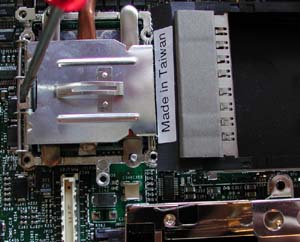
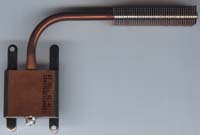
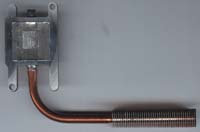

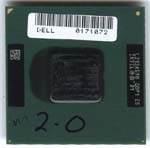
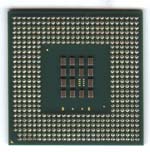

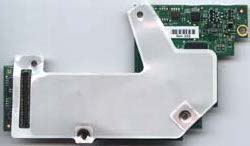
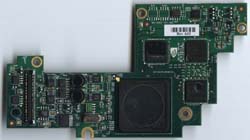

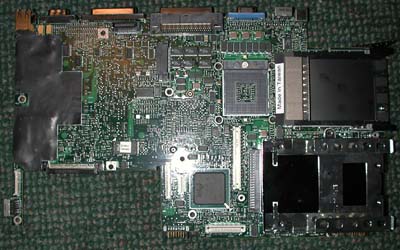








1 Comments
View All Comments
Anonymous User - Monday, July 7, 2003 - link
I have had this pc for about six months now, and I am still in awe. My setup was not as good as the test model here, my processor is a 1.7 GHz and only 384Mb ram and the ATI 9000. I use this laptop for web surfing and internet gaming, mainly Diablo II(HC). This machine ROX.....